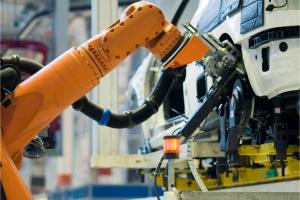With reshoring making its way back into the vernacular of job market conversations, we’re hearing a lot about a forthcoming reinvigorated, reinvented manufacturing industry.
According to a USA TODAY analysis of local data from Economic Modeling Specialists Intl. and CareerBuilder, an estimated 2.5 million new, middle-skill jobs like are expected to be added to the workforce by 2017, accounting for nearly 40% of all job growth.
So what’s the problem? A shortage in skilled talent.
-
While many addressing this problem are focused on post-secondary education and training, it’s important remember that getting future generations interested in manufacturing careers doesn’t start after high school.
High school years are formative years when students begin to seriously explore their interests and potential career paths, which might explain why one area of study in particular is picking up steam at the high school level – mechatronics engineering, a form of engineering that blends computer, electrical and mechanical disciplines.
In addition to giving students an opportunity to learn these skills before they enter college or certification program, high school mechatronics programs expose students to the world of manufacturing so that their decision to pursue such degrees and certifications are well informed.
So what goes into making your high school mechatronics program successful? Here are a few key pieces of advice:
Engage a local college or university.
Establishing a partnership that allows high school students to interact with their local college mechatronics program provides exposure to higher level mechatronics topics that they will encounter in post-secondary education and later in their careers.
Perhaps a local college teaches with an industrial robot or it has a manufacturing line in its mechatronics lab. These are features that most high schools simply don’t have the funds to invest in, but are key to showing students—beyond theory—what it looks like to have a career in mechatronics.
Find local industry mentors.
Industry mentors can be a huge asset to a high school mechatronics program.
Local manufacturing plants can offer plant tours for students to see real-world examples of how products are manufactured – and how manufacturing impacts the larger community. If field trips aren’t an option, industry partners are often willing to come to you and give classroom presentations or demo some of the latest manufacturing technologies.
In some cases, a mentor might want to get involved in a student project or competition where they can lend a hand or provide leadership based on their industry experience. For example, a local aircraft maintenance company might send in a mentor to help students build a sheet metal frame for a robot competition.
Finding a mentor can be as easy as reaching out to a local company’s Human Resources or Corporate Social Responsibility department to see if mentoring at a local high school is something they are willing to consider. In many cases the answer is yes because piquing students’ interest in mechatronics early will come back to them later down the road in the form of skilled employee prospects.
Explore articulation or dual enrollment opportunities.
Dual enrollment offers opportunities for students to jump start their college careers by earning credits toward a college degree or certificate while still in high school.
Beyond the valuable hands-on experience it gives students, it can also save them a lot of money between discounted credit hour rates and scholarships. Delaware County Community College is a great example of how a dual enrollment plan can save students 50 to 70 percent on the cost of transitioning directly into a four-year college.
Engage students at an even earlier age.
Don’t wait until high school to start the conversation with students about mechatronics. Most successful institutions employ some sort of outreach program for elementary and middle school students as well.
This outreach is often more broad, wrapping mechatronics into a larger program or hinting at mechatronics peripherally. For example, Northern Virginia Community College offers a variety of different summer STEM camps for rising 4th graders to 12th graders, many of which are focused on robotics. These types of camps can capture a student’s interest and spark their imagination about what a mechatronics career could mean to them.
Have you found a particular activity or partnership that has helped make your high school mechatronics program successful? Tells us about it.

Recent Comments